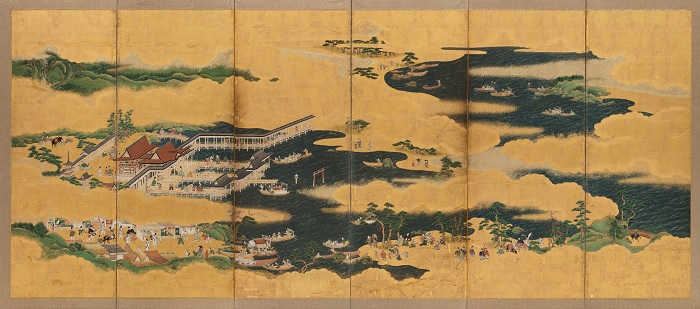
Unknown
Japanese, 17th c. CE, mid
Views of Itsukushima and Wakanoura, n.d.
ink, color, and gold leaf on paper; pair of six-panel folding screens
61 x 141 1/2 in.
SBMA, Museum Purchase, Peggy and John Maximus Fund
2017.26.1-2
COMMENTS
The vermillion lacquered Itsukushima Shrine, located at the beautiful Itsukushima, fits well with the Prussian blue sea, and the green of the virgin forest, recreating the elegance of the Heian era...
Although a major portion of the main buildings of Itsukushima Shrine were constructed during the Heian Period, due to fires and other calamities over time, the present main sanctuary was constructed in 1571 and the Marodo Shrine (shrine for the Guest Deity) was constructed in 1241. There may be slight differences in the details of the buildings which reflect the features of the particular period during which they were built, however the overall architectural style has been faithfully maintained... It can be said that the overall appearance of the shrine is a splendid example of Heian Period architecture. Skillfully incorporating the Shinden style of Japanese architecture, in addition to the free and uninhibited changes that are harmoniously blended into the construction, the shrine is said to be the finest example of this type of architecture existing in Japan. The Shinden style of architecture was used during the Heian Period for the construction of the residence of the Court and noble class, and an example of this style of architecture is the Imperial Palace in Kyoto...
The main shrine is constructed using the delicate and gorgeous Kiritsuma-ryonagare style, and at the front are greenish blue lacquered, folding, diamond-shaped lattice doors which extend a sense of elegance and grace. Although the present structure was constructed in 1571 by Mori Motonari, the same Heian architectural style which Kiyomori used was faithfully reproduced and the characteristic, graceful curving lines can be seen everywhere...
If you stand facing the sea at the Hitasaki ((Front Lantern) which is at the end of the projection from the Hirabutai (Broad Stage)), the deep blue sea extends all around and you will feel as though you were riding in a Heian Period houseboat.
- Miyajima Official Tourism Website, Hiroshima Prefecture, Japan
http://visit-miyajima-japan.com/en/culture-and-heritage/spiritual-heritage-temples-shrines/sanctuaire-itsukushima.html
SBMA CURATORIAL LABELS
These screens portray two of Japan's ancient, scenic locales famous for their Shinto shrines and beautiful environs. Located on Japan's Seto Island Sea, both were noted in court poetry ("waka") as early as the ninth century. From these early renderings of poetic imagery, "famous places" ("meisho") developed into one of the central themes of traditional Japanese painting.
When these screens were painted, more than one hundred years had passed since the civil wars. Peace and economic improvements encouraged people to travel for pilgrimages and leisure. The Tamatsushima Shrine (one of the three waka poety gods) in Wakanoura (right), and the Itsukushima Shrine are both marked by their red "torii" gates. The shrines’ precincts and surroundings are populated with figures from all classes: priests, courtiers, samurai, and commoners, many accompanied by children, some engaged in lively activities. Typical of the "meisho" images, seasonal activities are represented—cherry blossom viewing parties in the springtime (right screen) and music making under the red maple foliage in autumn (left).
These screens were likely produced by "machi-eshi" (town painters) who created the earliest paintings showing activities of all classes in the current time. These artists, whose paintings are typically unsigned, produced images eclectic in subject and style, with innovative figure manners and compositions that met the demands of a growing patron class in an increasingly wealthy society. The rich mineral pigments and abundant application of gold leaf indicate that the screens were created for a wealthy urbanite.
- Paths of Gold, 2018

